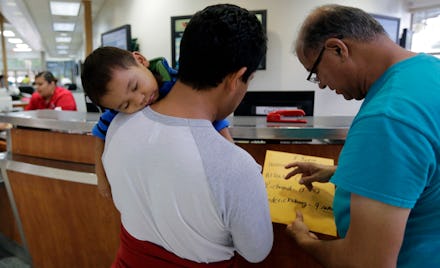A judge has ordered Trump to reunite separated families. Questions about how it will happen remain.

A federal judge from California halted President Donald Trump’s policy of separating immigrant parents from their children at the border on Tuesday, ordering that children younger than 5 be returned to their parents within 14 days and that children older than 5 be returned within 30 days.
In a scathing 24-page order, U.S. District Court Judge Dana Sabraw granted the American Civil Liberties Union the preliminary injunction the group had been seeking since March. Initially, the ACLU had filed the lawsuit on behalf of a Congolese mother who had been forcibly separated from her then-6-year-old daughter after arriving in the U.S. to seek asylum from religious persecution in the Democratic Republic of Congo.
After the mother and daughter were reunited in March, the ACLU expanded the case to a class-action lawsuit on behalf of other immigrants being harmed by the policy.
In his ruling from San Diego, Sabraw said that it was of note that the government is capable of keeping track of “personal property of detainees in criminal and immigration proceedings ... money, important documents, and automobiles, to name a few ... yet, the government has no system in place to keep track of, provide effective communication with, and promptly produce alien children.”
“The unfortunate reality is that under the present system migrant children are not accounted for with the same efficiency and accuracy as property,” he added. “Certainly, that cannot satisfy the requirements of due process.”
Lee Gelernt, deputy director of the ACLU’s Immigrants’ Rights Project and the lead lawyer who argued the case, said in a press release that the ruling is “an enormous victory for parents and children who thought they may never see each other again.”
“Tears will be flowing in detention centers across the country when the families learn they will be reunited,” Gelernt said.
Although the preliminary injunction will indeed be welcome news to the parents of the more than 2,300 children who have been separated as a result of the policy, the government has thus far offered little in terms of concrete plans to reunite the families.
On Saturday night, the Department of Homeland Security released a preliminary plan for how family reunification would work, but emphasized that it would not happen overnight.
In the report, the agency also confirmed that 522 children had already been reunited with their families in the days after Trump signed an executive order aimed at curtailing the practice. But on Tuesday, in a call with reporters, the agency hedged a bit on those numbers, explaining that those were children who had never entered Health and Human Services custody in the first place, Talking Points Memo’s Alice Ollstein reported.
Because the Trump administration’s “zero tolerance” policy on immigration was rolled out and implemented in such short order — it was first announced by Attorney General Jeff Sessions in May — many have speculated that the government lacked the necessary timeframe to install a system that would allow for a swift and efficient family reunification process.
“Either the government wasn’t thinking at all about how they were going to put these families back together, or they decided they just didn’t care,” Natalia Cornelio, an attorney with the Texas Civil Rights Project, told the Washington Post on Thursday.
While the Trump administration scrambles to comply with the deadlines outlined in the preliminary injunction, the American Academy of Pediatrics has warned that we should be racing against an even more important deadline: the irreparable harm long-term separation can inflict upon children.
“This type of prolonged exposure to serious stress — known as toxic stress — can carry lifelong consequences for children,” the group wrote in a May statement.